|
Family: Picidae (woodpeckers)
Life > Eukaryotes > Opisthokonta > Metazoa (animals) > Bilateria > Deuterostomia > Chordata > Craniata > Vertebrata (vertebrates) > Gnathostomata (jawed vertebrates) > Teleostomi (teleost fish) > Osteichthyes (bony fish) > Class: Sarcopterygii (lobe-finned fish) > Stegocephalia (terrestrial vertebrates) > Tetrapoda (four-legged vertebrates) > Reptiliomorpha > Amniota > Reptilia (reptiles) > Romeriida > Diapsida > Archosauromorpha > Archosauria > Dinosauria (dinosaurs) > Saurischia > Theropoda (bipedal predatory dinosaurs) > Coelurosauria > Maniraptora > Aves (birds) > Order: Piciformes
Species indigenous to southern Africa
|
Campethera
abingoni (Golden-tailed woodpecker) The Golden-tailed woodpecker is fairly common in sub-saharan
Africa, preferring riparian, Miombo and Mopane woodland. It mainly forages in
trees, tapping and probing branches, looking for insects and licking them up with
its barbed tongue. Both sexes excavate the nest, which is usually a hole in the underside of
a tree branch. Here it lays 2-3 eggs, which are incubated by both sexes for about 13
days. The chicks are cared for by both parents, eventually leaving the nest
after about 22-25 days. They become fully independent a few weeks after
fledging. |
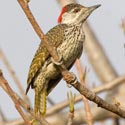 |
|
Campethera
bennettii (Bennett's woodpecker) The
Bennett's woodpecker is found from Tanzania south to southern Africa, where
it occurs in deciduous woodland and savanna with tall trees. It feeds mainly
on ants, their their eggs and pupae, foraging them by excavating underground
ant nests, scooping them up with its sticky tongue. It uses cavities in
trees as nests, making it themselves are using pre-existing holes. It lays
2-6 eggs, which are incubated by both sexes, for 15-18 days. The chicks stay
in the nest for 26-27 days, after which they remain dependent on their
parents until the next breeding season. |
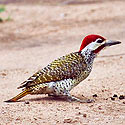 |
|
Campethera
cailliautii (Green-backed
woodpecker, Little spotted woodpecker) |
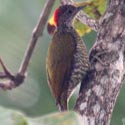 |
|
Campethera
notata (Knysna woodpecker) The Knysna
woodpecker is endemic to South Africa, being found in woodlands and thickets
along the southern coastline. It mainly forages in trees, searching dead
branches for invertebrates and gleaning ants from branch and leaves. Both
sexes excavate the nest, which is usually a hole in the underside of a
branch, often reused over multiple breeding seasons. Here it lays 2-4 eggs,
which are incubated for roughly 21-13 days (estimated). The chicks are fed
by both parents, and stay in the nest for an estimated 25-27 days. |
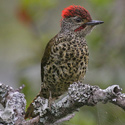 |
|
Campethera
scriptoricauda (Speckle-throated woodpecker) |
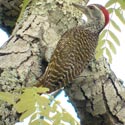 |
|
Dendropicos
fuscescens (Cardinal woodpecker) The Cardinal
woodpecker is probably the most common and widespread of all African
arboreal woodpeckers, with a range extending across sub-Saharan Africa. It
is an extremely agile forager, gleaning ants and termites from bark and
leaves, breaking open seed pods and even feeding on fruit. Both sexes
excavate the nest, which is usually a hole in the underside of a tree
branch. Here it lays 1-3 eggs, which are incubated by both sexes for about
12-13 days. The chicks are cared for by both parents, eventually leaving the
nest after about 27 days. They become fully independent 1-2 months after
fledging. |
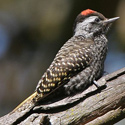 |
|
Dendropicos
griseocephalus (Olive woodpecker) The Olive
woodpecker has two isolated subspecies in Africa - one is in Central Africa,
and the other is endemic to South Africa, living in evergreen forests. It
forages in the upper canopies of trees, probing pecking branches, and
licking them up with its barbed tongue. Both sexes excavate the nest, which
is usually a oval-shaped hole in the trunk of a tree. Here it lays 2-3 eggs,
which are incubated by both sexes, for roughly 15-16 days. The chicks are
cared for by both parents, leaving the nest at about 24-26 days old. The
juveniles return to the nest to roost for about 3 months, at which point
they become fully independent. |
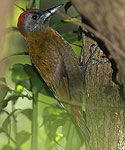 |
|
Dendropicos
namaquus (Bearded woodpecker) The Bearded woodpecker occurs from central Africa to southern
Africa, absent largely from the DRC. It dislikes dense forest, preferring
deciduous woodland and savanna. It mainly forages in trees, tapping and probing
branches in search of insects, licking them up with its barbed tongue. Both
sexes excavate the nest, which is usually a oval-shaped hole in the trunk of a
tree, although it has been recorded nesting in fence posts. Here It lays 1-3 eggs, which are incubated by both sexes, for roughly
13
days. The chicks are cared for by both parents, leaving the nest at about 27
days old. The juveniles become fully independent roughly 1-2 months after
fledging. |
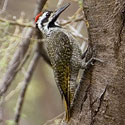 |
|
Geocolaptes
olivaceus (Ground woodpecker) The Ground
woodpecker is endemic to South Africa, Swaziland and Lesotho, being found in
hilly, mountainous areas. It has a highly specialized
diet, with about 99.8% of its diet ants, digging up subsurface ant nests,
licking them up with its sticky tongue. Its nest is excavated by both sexes,
and consists of a tunnel
and egg chamber, normally dug into earthen banks. It lays 2-4 eggs, which are
incubated by both sexes. The chicks are cared for by both parents, begging
loudly for them to regurgitate food (see image). The fledglings stay
dependent on their parents until the onset of the next breeding season. |
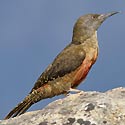 |
|
Jynx
ruficollis (Red-throated wryneck) The
Red-throated wryneck has populations scattered across sub-saharan Africa,
including one confined to South Africa and Swaziland. It is highly
specialized, living only in grassland, and feeding exclusively on ants and
termites. It usually nests in tree cavities made by other birds, but it also
can use natural tree holes and nest boxes. It lays 16, usually 3-4 eggs,
which are incubated by both sexes for about 13 days. The chicks are cared
for by both parents, staying in the nest for about 25-26 days. The juveniles
become independent soon after fledging. |
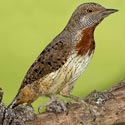 |
|
